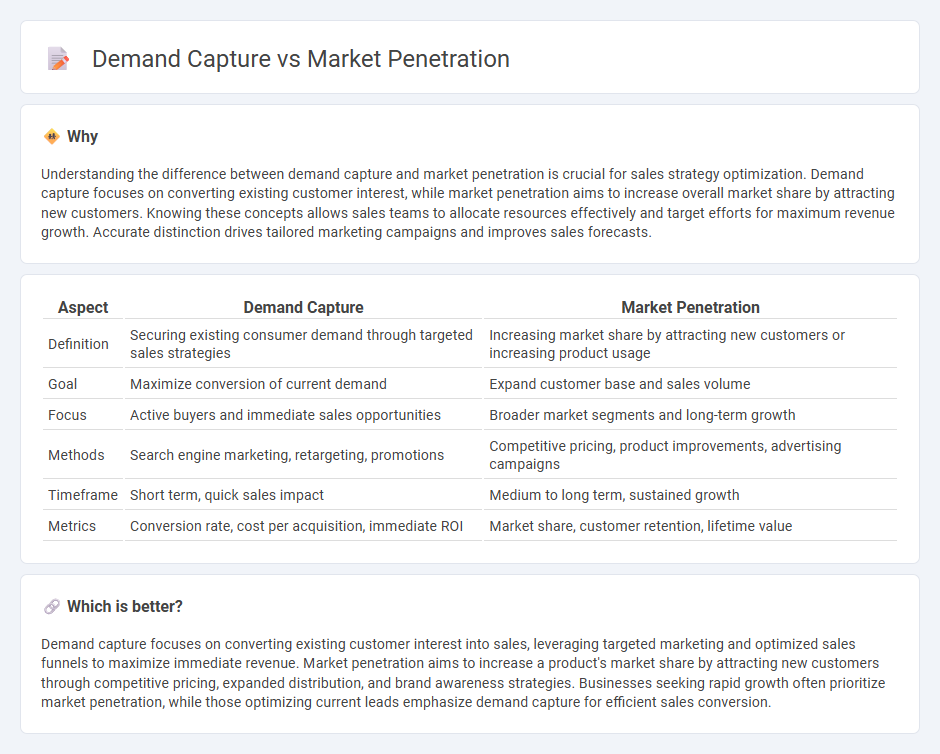
Demand capture focuses on converting existing customer interest into sales by targeting active buyers ready to make a purchase, while market penetration aims to increase market share by attracting new customers and expanding product usage among existing consumers. Effective sales strategies integrate demand capture techniques like lead nurturing and personalized offers with market penetration tactics such as competitive pricing and promotional campaigns. Explore detailed methods to enhance both demand capture and market penetration to drive sustainable sales growth.
Why it is important
Understanding the difference between demand capture and market penetration is crucial for sales strategy optimization. Demand capture focuses on converting existing customer interest, while market penetration aims to increase overall market share by attracting new customers. Knowing these concepts allows sales teams to allocate resources effectively and target efforts for maximum revenue growth. Accurate distinction drives tailored marketing campaigns and improves sales forecasts.
Comparison Table
| Aspect | Demand Capture | Market Penetration |
|---|---|---|
| Definition | Securing existing consumer demand through targeted sales strategies | Increasing market share by attracting new customers or increasing product usage |
| Goal | Maximize conversion of current demand | Expand customer base and sales volume |
| Focus | Active buyers and immediate sales opportunities | Broader market segments and long-term growth |
| Methods | Search engine marketing, retargeting, promotions | Competitive pricing, product improvements, advertising campaigns |
| Timeframe | Short term, quick sales impact | Medium to long term, sustained growth |
| Metrics | Conversion rate, cost per acquisition, immediate ROI | Market share, customer retention, lifetime value |
Which is better?
Demand capture focuses on converting existing customer interest into sales, leveraging targeted marketing and optimized sales funnels to maximize immediate revenue. Market penetration aims to increase a product's market share by attracting new customers through competitive pricing, expanded distribution, and brand awareness strategies. Businesses seeking rapid growth often prioritize market penetration, while those optimizing current leads emphasize demand capture for efficient sales conversion.
Connection
Demand capture directly influences market penetration by converting potential customer interest into actual sales, thereby expanding a company's market share. Effective demand capture strategies leverage targeted marketing and sales efforts to identify and satisfy customer needs, facilitating deeper market infiltration. As sales increase through captured demand, businesses reinforce their competitive position and accelerate market penetration within their industry.
Key Terms
Market Share
Market penetration measures the success of a product in gaining market share relative to competitors, emphasizing the percentage of potential customers acquired within a target market. Demand capture focuses on converting existing market demand into actual sales, highlighting the efficiency of marketing and sales strategies in meeting consumer needs. Explore further to understand how optimizing market share through these strategies can drive business growth and competitive advantage.
Lead Generation
Market penetration strategy emphasizes expanding customer base by increasing product or service adoption within existing markets, while demand capture targets actively converting interested prospects through lead generation tactics. Lead generation optimizes demand capture by employing techniques such as content marketing, targeted advertising, and personalized outreach to attract and qualify potential customers. Explore in-depth methods to boost your lead generation efficiency and capture market demand effectively.
Customer Acquisition
Market penetration measures the extent to which a product or service is adopted by a target market, often expressed as a percentage of total potential customers reached. Demand capture focuses on the effectiveness of strategies that convert existing market interest into actual purchases, highlighting the efficiency of customer acquisition efforts. Explore deeper insights into optimizing customer acquisition by understanding the balance between market penetration and demand capture.
Source and External Links
Market penetration | EBSCO Research Starters - Market penetration measures the percentage of a consumer market using a product, helping businesses identify unserved market segments and grow customer base without changing products, linked closely with market share.
Grow in Your Markets with a Successful Market Penetration Strategy - Market penetration strategies focus on increasing market share by enhancing existing products, adjusting pricing, increasing brand awareness, targeting customer segments, and boosting customer loyalty within known markets.
What Is Market Penetration Strategy - Definition, Rate & More - Market penetration strategy is about expanding or saturating an existing market with current or new products and calculating the penetration rate as (number of customers/TAM)x100 to gauge growth opportunities.
 dowidth.com
dowidth.com